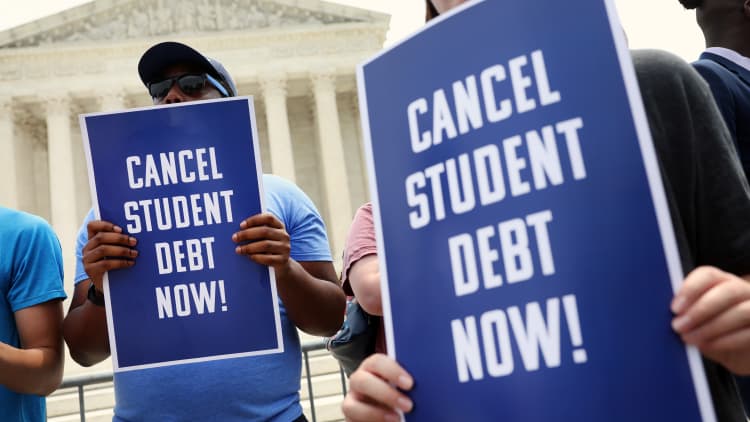D3sign | Moment | Getty Images
As the affordable options and relief measures for federal student loan borrowers pile up, consumer advocates advise caution before refinancing your debt.
“How’s this for a warning? DON’T!” Betsy Mayotte, president of The Institute of Student Loan Advisors, wrote in an email to CNBC.
Refinancing your federal student loans turns them into a private student loan and transfers the debt from the government to a private company. Borrowers usually refinance in search of a lower interest rate.
However, many people don’t realize what they’re getting into, said Persis Yu, deputy executive director at the Student Borrower Protection Center.
“We’ve seen aggressive marketing by a number of private lenders to try to lure folks away from the federal student loan space,” Yu said. “And we have seen, time and time again, private student loan borrowers left out of many of the programs they really need.”
More from Personal Finance:
Interest rates on federal student loans may increase by 1 percentage point
IRS: Time to claim $1 billion in tax refunds from 2020 expires May 17
New grads may have a harder time landing their dream job
Mayotte has witnessed the same: “Borrowers who refinance their federal loans into private forever lose access to the safety nets and lower payment options unique to federal loans.”
David Green, CEO of Earnest, an online lender, said that refinancing can be “life-changing” for those who are excluded from the government’s relief options because of their earnings or other reasons.
“Consider taking advantage of [forgiveness] before looking at refinancing,” Green said.
“While we can’t predict the future of forgiveness options, if you make above the initial salary limit the federal government proposed, or otherwise don’t qualify for a loan forgiveness program, then refinancing might be a good option to explore,” he said.
“You may spend less time paying off your loan, or have a more reasonable monthly payment, which can save a significant amount in interest over the life of your loan,” Green added.
Refinancing is risky ahead of Plan B forgiveness
Consumer advocates have long pointed out that private lenders don’t provide the same range of relief options as does the U.S. Department of Education. (For example, federal student loan borrowers can pause their payments if they become unemployed, return to school or get cancer.)
But advocates have fresh warnings now as the Biden administration reforms the federal student loan system.
While President Joe Biden has been in office, the Education Department has cleared the federal education loans of nearly 4.6 million people, totaling almost $160 billion in aid. Most of that relief came through expanding access to relief programs.
Millions more federal student loan borrowers could receive debt forgiveness in the coming months if Biden’s revised relief package survives legal challenges this time.
Immediately after the Supreme Court blocked the president’s first aid package, his administration began working on a Plan B. More than 25 million borrowers still stand to benefit from the program, including those who’ve been in repayment for decades or seen their balance grow from interest.
Borrowers lose access to relief programs
Borrowers who refinance their loans lose their eligibility for the government’s debt cancellation, Mayotte said.
One potential loss is no longer qualifying for the Public Service Loan Forgiveness program, she said. PSLF allows certain not-for-profit and government employees to have their federal student loans cleared after 10 years of on-time payments.
“I’ve worked with too many borrowers who have done [refinancing] only to find out their loans would have been forgiven under PSLF,” Mayotte said.

Mayotte also recently heard from one borrower who said they’d refinanced based on advice from their financial advisor — and as a result, missed out on having their more than $400,000 balance forgiven when the Education Department excused 317,000 former Art Institute students of their debts earlier this month.
“[It] was heartbreaking,” Mayotte said.
The U.S. Department of Education, which reviewed evidence provided by the attorneys general of Iowa, Massachusetts and Pennsylvania, concluded that the for-profit Art Institute chain of schools and its parent company, the Education Management Corp., or EDMC, made “pervasive and substantial” misrepresentations to prospective students about post-graduation employment rates, salaries and career services.
Repayment options are a ‘huge, huge difference’
Income-driven repayment plans, meanwhile, allow federal student borrowers to pay just a share of their discretionary income toward their debt each month. The plans also lead to debt forgiveness after a certain period, usually somewhere between 10 and 25 years.
Most recently, the Biden administration introduced a repayment plan that lowers the percentage borrowers need to pay of their earnings to 5%, compared with 10% or more under existing programs. The new option, called The Saving on a Valuable Education, or SAVE plan, will leave some people with a monthly bill of $0.
“There is no right to an affordable repayment plan with private student loans, and that’s a huge, huge difference between the federal student loan space and the private loan space,” Yu said.
Much lower interest rate not a guarantee
The top reason people refinance their federal student loans is to pick up a lower interest rate. But that may not be so easy to do right now, said higher education expert Mark Kantrowitz.
“Interest rates are high,” Kantrowitz said, estimating that those who refinance pick up a rate between 5% and 11%. (The rates on federal student loans for the 2024-2025 academic year will range from roughly 6.5% to 9%.)
Refinancing likely only makes sense for borrowers with the best credit — a score above 800 — since they’re the only ones likely to gain a significantly lower interest rate, Kantrowitz added.
Still, any borrower considering the move should look closely at what protections and possible forgiveness opportunities they’re forfeiting, he said.
